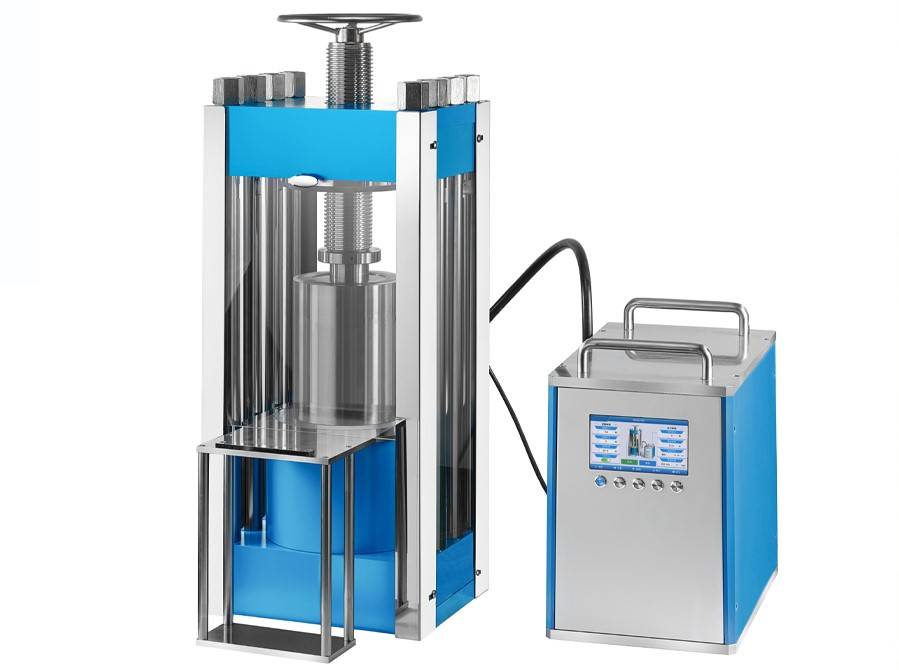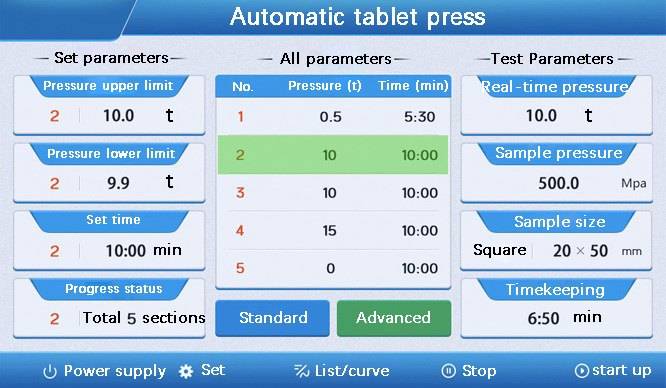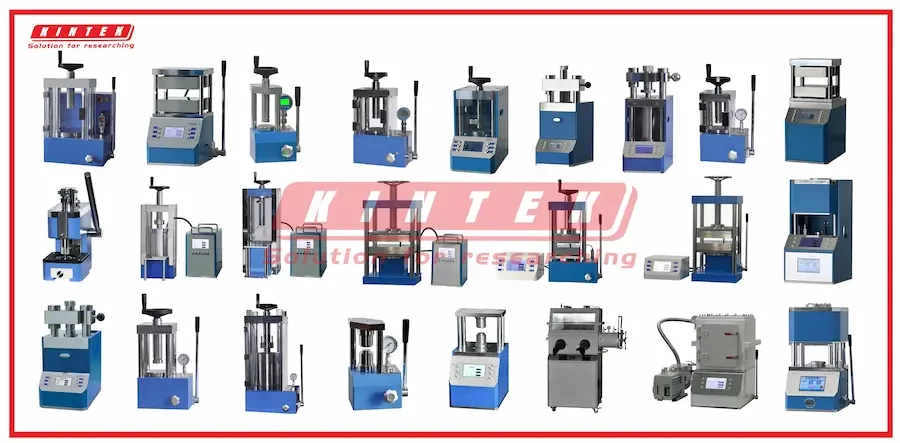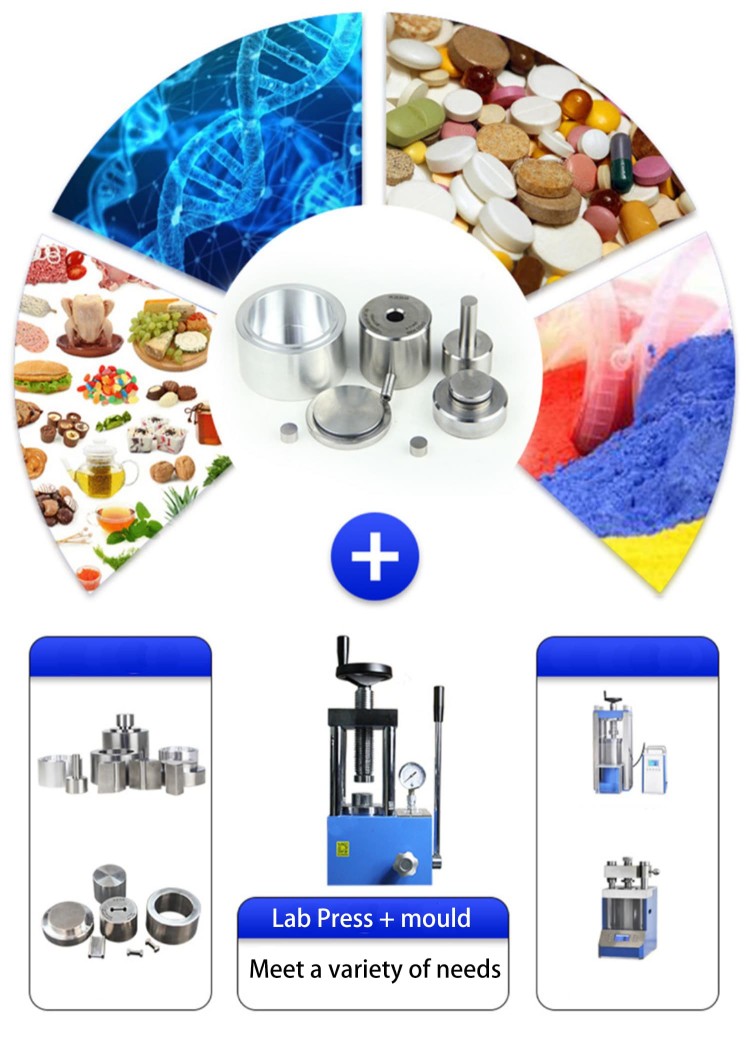
Isostatic Press
Electric Split Lab Cold Isostatic Press CIP Machine for Cold Isostatic Pressing
Item Number : PCESI
Price varies based on specs and customizations
- Working pressure
- 0-200 T
- Piston diameter
- φ160-φ290 mm
- Isostatic pressure
- 0-300 MPa
Shipping:
Contact us to get shipping details Enjoy On-time Dispatch Guarantee.
Why Choose Us
Reliable PartnerEasy ordering process, quality products, and dedicated support for your business success.
Applications
Lab Electric Cold Isostatic Press is widely used in material researching labs, pharmacy, catalytic reaction, ceramics, electronic industries, it is one high efficient equipment for the sample preparing, due to its small footprint, it easy to carry and move, can work inside the vacuum glove box for processing under vacuum environment.
By applying equal pressure to each surface of the sample, the Lab Electric Isostatic Press increases the density of the sample by applying a high pressure environment, and obtains a sample of the desired shape.
Split isostatic presses are capable of providing higher pressures, making them suitable for testing applications that require high pressure levels.
Feature
- Small footprint, light weight, easy to carry and move, nice fitting vacuum glove box
- High precision digital pressure gauge
- Pressure can be programmed, hydraulic will restart working when pressure drops to set value
- Isostatic press creates a higher and even pressure around the samples,increase sample density
- The split structure can provide even more than 200T pressure
- Can be customized according to your needs
Detail & Parts




Operation interface

- Standard interface: You can set various parameters, pressure, demolding, time, sample size, etc. in this interface.
- Pressurization button: Pressurize according to the parameters set in the interface.
- Stop button: Press the stop button to stop pressurization during pressurization.
- Demolding button: Press the demolding button to demold the sample according to the demolding pressure.
- Timing switch: You can turn the timing function on and off.

- Start button: Pressurize according to multiple pressurization programs.
- Stop button: During pressurization, you can stop the pressurization process.
- Setting button: Click the setting button to enter the setting menu.

- List/curve: You can switch between list and curve display.
Principle
- Automatic: Programmed pressurization, easy operation and other advantages, suitable for high-end laboratories.
- Volume: small size, strong pressure, high cost performance, suitable for use in various laboratories.
- Display: LCD screen display, the operation is more intuitive and the display is clearer. Convenient for users to operate.
Advantages
- The upper plate adopts electroplated countersunk head hexagonal screws, beautiful and space-saving
- Chrome-plated cylinder, smooth surface, no rust, good sealing rubber ring, no oil leakage
- One-piece main board structure, oil pool, main board, oil cylinder in a body, no seal connection
- Extended pulling spring, good rebound effect, not easy to deformation, can achieve the cylinder 30mm return without deformation
- All aluminum alloy hand wheel, beautiful, practical, not easy to break
- Small size, light weight, no oil leakage, can be used in the glove box
- Mold using Japanese high-speed steel, good material, high hardness, no deformation, long service life
- Digital display pressure gauge, more accurate pressure control, pressure display accuracy of 0.01MPa
- Oil pool outside the host, easy to replace the oil, and the oil circuit increased the hydraulic oil filtration device
- Special plunger, using special custom sealing structure, excellent sealing effect
- Pressurizing device, placed in the lowermost corner of the mainframe, the angle is reasonable, pressurizing force does not tilt back
Technical specifications
| Instrument model | PCESI-65T | PCESI-100T | PCESI-150T | PCESI-200T |
|---|---|---|---|---|
| Pressure Range | 0-65T | 0-100T | 0-150T | 0-200T |
| Piston diameter | 160mm (d) in chrome plated oil cylinder | 200mm (d) in chrome plated oil cylinder | 200mm (d) in chrome plated oil cylinder | 290mm (d) in chrome plated oil cylinder |
| Pressurization process | Program pressurization - Program holding -Timed pressure relief | Program pressurization -Program holding -Timed pressure relief | Program pressurization - Program holding-Timed pressure relief | Program pressurization - Program holding -Timed pressure relief |
| Pressure conversion | The program automatically converts the pressure borne by the sample | The program automatically converts the pressure borne by the sample | The program automatically converts the pressure borne by the sample | The program automatically converts the pressure borne by the sample |
| Display | 7-inch LCD screen | 7-inch LCD screen | 7-inch LCD screen | 7-inch LCD screen |
| Equipment protection | Steel plate protection with organicglass door | Steel plate protection with organicglass door | Steel plate protection with organic glass door | Steel plate protection with organicglass door |
| lsostatic pressure | 0-300MPa | 0-300MPa | 0-300MPa | 0-300MPa |
| lsostatic pressure chamber | Φ50×150mm(M×N) | Φ60×150mm(M×N) | Φ80×150mm(M×N) | Φ90×150mm(M×N) |
| Cylinder stroke (T) | 50mm | 50mm | 50mm | 50mm |
| Space size | 220×400mm(M×N) | 260×400mm(M×N) | 280×400mm(M×N) | 290×420mm(M×N) |
| External dimensions | 700×450×1050mm(L×W×H) | 850×500×1100mm(L×W×H) | 950×550×1150mm(L×W×H) | 1000×650×1200mm(L×W×H) |
| Equipment power supply | 1500W(220V/110 can be customized) | 1500W (220V/110 can be customized) | 1500W(220V/110 can be customized) | 1500W(220V/110 can be customized) |
| Equipment weight | 350kg | 580kg | 680kg | 980kg |

Operating steps
How to replace accessories and precautions
The operation of Electric Split Lab Isostatic Press is as follows:

1.In the manual interface, you can set pressure, time, sample size, etc.

2. Select the item to be modified, a small keyboard will pop up, enter the parameters and save.

3. Press the pressurization button and the device starts normal pressurization.

4. Press the setting button to enter the setting menu.

5. Enter the program setting, you can set up to 5 tons of program pressurization, click call, and return to the automatic operation interface.

6. Return to the automatic operation interface.

7. Press the curve to display the real-time pressure curve, and connect the computer to print the spectrum and experimental report.

8. Click Start to start multi-stage program pressurization.

9. Pressurization is completed.

10. Take out the sample.
Full range of lab press types

Click to view our full range of lab press products.
Any question? Our experts have helped many laboratories choose their lab press, contact us now!
Full range of types of laboratory press molds
We have a full range of molds for you to choose from, and the molds fit the body perfectly.
If you need molds with special shapes, we can also customize them for you.

Warnings
Operator safety is the top important issue! Please operate the equipment with cautions. Working with inflammable& explosive or toxic gases is very dangerous, operators must take all necessary precautions before starting the equipment. Working with positive pressure inside the reactors or chambers is dangerous, operator must fellow the safety procedures strictly. Extra caution must also be taken when operating with air-reactive materials, especially under vacuum. A leak can draw air into the apparatus and cause a violent reaction to occur.
Designed for You
KinTek provide deep custom made service and equipment to worldwide customers, our specialized teamwork and rich experienced engineers are capable to undertake the custom tailoring hardware and software equipment requirements, and help our customer to build up the exclusive and personalized equipment and solution!
Would you please drop your ideas to us, our engineers are ready for you now!
FAQ
What Is A Lab Press?
What Is Isostatic Pressing?
What Are The Benefits Of Isostatic Pressing?
What Is Cold Isostatic Pressing (CIP)?
Cold Isostatic Pressing (CIP) is a process used to compact and mold powders and other materials into a desired shape by applying hydrostatic pressure at room temperature. The process is performed using a flexible mold, typically made of rubber or plastic, that is filled with a liquid pressure medium such as water, oil, or a specialized fluid.
What Is The Purpose Of A Hydraulic Press In Lab?
What Are The Types Of Isostatic Pressing?
There are two main types of isostatic pressing:
- Hot Isostatic Pressing (HIP): This type of isostatic pressing uses high temperature and high pressure to consolidate and strengthen the material. The material is heated in a sealed container and then subjected to equal pressure from all directions.
- Cold Isostatic Pressing (CIP): In this type of isostatic pressing, the material is compacted at room temperature using hydraulic pressure. This method is commonly used to form ceramic and metal powders into complex shapes and structures.
What Are Different Type Of Lab Presses?
What Type Of Isostatic Pressing Equipment Do You Have?
What Are The Advantages Of Cold Isostatic Pressing?
- High green strength: Machining of the compacted material in its green state becomes more feasible.
- Materials that are hard to press: Isostatic pressing can be performed on powders without the need for water, lubricants, or binders, making it applicable to a wider range of materials.
- Predictable shrinkage during sintering is achieved due to the high compaction and uniform density.
- Time and cost savings in post-processing are possible due to the ability to create large, complex, and near-net shapes.
- Large aspect ratio parts with uniform density can be produced, resulting in improved quality.
- Green strength enables efficient in-process handling and treatment, reducing production costs.
What Is A Cold Isostatic Press?
A cold isostatic press (CIP) is a machine used to compact and mold powders and other materials into a desired shape.
The process works by filling a flexible mold, usually made of rubber or plastic, with a liquid pressure medium like water, oil, or a specialized fluid. This mold is then placed in a closed container, and equal pressure is applied to each surface to achieve a high-pressure environment.
The pressure results in an increase in the product's density and allows it to take on the desired shape.
Cold isostatic pressing is performed at room temperature, in contrast to hot isostatic pressing which is carried out at higher temperatures.
What Are The Wet Bag Process And The Dry Bag Process?
The CIP molding process is divided into two methods: the wet bag process and the dry bag process.
Wet bag process:
In this method, the powder material is placed in a flexible mold bag and placed in a pressure vessel filled with high-pressure liquid. This process is ideal for producing multi-shaped products and is suitable for small to large quantities, including large-sized parts.
Dry bag process:
In the dry bag process, a flexible membrane is integrated into the pressure vessel and is used throughout the pressing process. This membrane separates the pressure fluid from the mold, creating a "dry bag." This method is more hygienic as the flexible mold does not get contaminated with wet powder and requires less cleaning of the vessel. It also features fast cycles, making it ideal for mass producing powder products in an automated process.
Application Field Of Cold Isostatic Press?
Cold Isostatic Pressing is widely used for various applications, including the consolidation of ceramic powders, compression of graphite, refractory materials, and electrical insulators, as well as the production of fine ceramics for dental and medical applications.
This technology is also making inroads into new fields such as pressing sputtering targets, coating valve parts in engines to reduce wear on cylinder heads, telecommunications, electronics, aerospace, and automotive industries.
What Are The Wearing Parts Of Cold Isostatic Pressing Equipment?
The wearing parts of cold isostatic equipment are mainly various seals, such as various types of seal rings, valve cores and valve seats.
Do You Provide Matching Cold Isostatic Press Molds?
We offer a variety of standard mold shapes for customers to experiment or validate their process. Custom mold design services are also available upon request.
How Long Is Your Delivery Time? If I Want To Customize The Instrument, How Long Does It Take?
4.8
out of
5
I was amazed by how quickly I received my order. It arrived in just a few days, which was much faster than I had expected. The product was well-packaged and in perfect condition.
4.9
out of
5
I am very impressed with the quality of the product. It is well-made and durable, and it has exceeded my expectations. I would definitely recommend this product to others.
4.7
out of
5
The product is a great value for the price. It is affordable and offers a lot of features that are not found on other products in this price range.
4.8
out of
5
I am very satisfied with the product. It is easy to use and has made my work much easier. I would definitely recommend this product to others.
4.9
out of
5
I am very impressed with the customer service I received from this company. They were very helpful and responsive to my questions. I would definitely recommend this company to others.
4.7
out of
5
The product arrived quickly and in good condition. I am very happy with the product and would definitely recommend it to others.
4.8
out of
5
I am very satisfied with the product. It is well-made and durable, and it has exceeded my expectations. I would definitely recommend this product to others.
4.9
out of
5
I am very impressed with the quality of the product. It is well-made and durable, and it has exceeded my expectations. I would definitely recommend this product to others.
4.7
out of
5
The product is a great value for the price. It is affordable and offers a lot of features that are not found on other products in this price range.
4.8
out of
5
I am very satisfied with the product. It is easy to use and has made my work much easier. I would definitely recommend this product to others.
4.9
out of
5
I am very impressed with the customer service I received from this company. They were very helpful and responsive to my questions. I would definitely recommend this company to others.
4.7
out of
5
The product arrived quickly and in good condition. I am very happy with the product and would definitely recommend it to others.
4.8
out of
5
I am very satisfied with the product. It is well-made and durable, and it has exceeded my expectations. I would definitely recommend this product to others.
4.9
out of
5
I am very impressed with the quality of the product. It is well-made and durable, and it has exceeded my expectations. I would definitely recommend this product to others.
4.7
out of
5
The product is a great value for the price. It is affordable and offers a lot of features that are not found on other products in this price range.
4.8
out of
5
I am very satisfied with the product. It is easy to use and has made my work much easier. I would definitely recommend this product to others.
4.9
out of
5
I am very impressed with the customer service I received from this company. They were very helpful and responsive to my questions. I would definitely recommend this company to others.
4.7
out of
5
The product arrived quickly and in good condition. I am very happy with the product and would definitely recommend it to others.
4.8
out of
5
I am very satisfied with the product. It is well-made and durable, and it has exceeded my expectations. I would definitely recommend this product to others.
REQUEST A QUOTE
Our professional team will reply to you within one business day. Please feel free to contact us!
Related Products

Electric Lab Cold Isostatic Press CIP Machine for Cold Isostatic Pressing
Produce dense, uniform parts with improved mechanical properties with our Electric Lab Cold Isostatic Press. Widely used in material research, pharmacy, and electronic industries. Efficient, compact, and vacuum-compatible.

Automatic Lab Cold Isostatic Press CIP Machine Cold Isostatic Pressing
Efficiently prepare samples with our Automatic Lab Cold Isostatic Press. Widely used in material research, pharmacy, and electronic industries. Provides greater flexibility and control compared to electric CIPs.

Cold Isostatic Pressing Machine CIP for Small Workpiece Production 400Mpa
Produce uniformly high-density materials with our Cold Isostatic Press. Ideal for compacting small workpieces in production settings. Widely used in powder metallurgy, ceramics, and biopharmaceutical fields for high-pressure sterilization and protein activation.

Isostatic Molding Pressing Molds for Lab
Explore high-performance isostatic pressing molds for advanced material processing. Ideal for achieving uniform density and strength in manufacturing.

Efficient split chamber CVD furnace with vacuum station for intuitive sample checking and quick cooling. Up to 1200℃ max temperature with accurate MFC mass flowmeter control.

Warm Isostatic Press WIP Workstation 300Mpa for High Pressure Applications
Discover Warm Isostatic Pressing (WIP) - A cutting-edge technology that enables uniform pressure to shape and press powdered products at a precise temperature. Ideal for complex parts and components in manufacturing.

Warm Isostatic Press for Solid State Battery Research
Discover the advanced Warm Isostatic Press (WIP) for semiconductor lamination. Ideal for MLCC, hybrid chips, and medical electronics. Enhance strength and stability with precision.
Related Articles

Electric Lab Cold Isostatic Press (CIP): Applications, Benefits, and Customization
Explore the versatile world of Electric Lab Cold Isostatic Press (CIP) technology. Learn about its applications in various industries, benefits, and customization options for tailored solutions.

How Isostatic Presses Improve the Efficiency of Material Processing
Isostatic pressing is a manufacturing process that uses high pressure to compact and shape materials. It can be done at room temperature (cold isostatic pressing) or at high temperatures (hot isostatic pressing).

Isostatic Pressing Technology: Revolutionizing Ceramic Material Densification
Explore how isostatic pressing techniques enhance ceramic properties, achieving 100% theoretical density and eliminating porosity.

Beyond Brute Force: The Quiet Power of Cold Isostatic Pressing
Learn how Cold Isostatic Pressing overcomes the hidden defects of traditional methods by using uniform fluid pressure to ensure material reliability.

Beyond the Press: Why Uniform Density Is the Bedrock of Advanced Materials
Discover how cold isostatic pressing (CIP) eliminates hidden density variations, a critical step for creating reliable, high-performance components.

Uniformity Over Form: The Hidden Genius of Cold Isostatic Pressing
Discover why Cold Isostatic Pressing sacrifices initial shape accuracy to achieve the uniform density critical for flawless, high-integrity final parts.

Forging Perfection: The Hidden Battle Against Material Flaws with CIP and HIP
Explore the difference between Cold (CIP) and Hot (HIP) Isostatic Pressing, two critical processes for forming and perfecting materials.

Beyond Brute Force: Why Your Complex Forgings Fail—And How to Fix Them for Good
Discover why more forging power fails. Learn the difference between impact and pressure to fix inconsistent results and master complex forgings.

Understanding Cold Isostatic Pressing and Its Applications
Cold isostatic pressing (CIP) is a method of processing materials. It involves compacting powders by enclosing them in an elastomer mold and applying uniform liquid pressure to compress the mold. This results in a highly compact solid. Cold isostatic pressing is commonly used for plastics, graphite, powdered metallurgy, ceramics, sputtering targets, and other materials.

Hot & Cold Isostatic Pressing: Applications, Process, and Specifications
Hot Isostatic Pressing (HIP) is a manufacturing process that involves the simultaneous application of high temperature and pressure to metals and other materials. The purpose of HIP is to reduce the porosity of metals and increase the density of ceramic materials. This process improves the mechanical properties and workability of the materials.

Cold Isostatic Pressing (CIP): A Proven Process for High-Performance Parts Manufacturing
Cold isostatic pressing (CIP) is a proven process that stands out when it comes to high-performance part manufacturing. The technology offers a range of advantages, from achieving superior densities in ceramics to compressing materials as diverse as metals and graphite.

Split isostatic pressing operation steps
Introduction to the steps of split isostatic pressing.